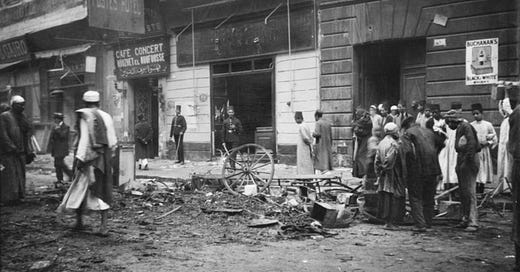The Australian War Memorial (AWM) is an extremely well-funded institution created to disseminate and popularise war propaganda. When it acknowledges Australian military atrocities at all, it does so with overt racism, chauvinism and a complete deference to imperialist hegemony.
This week, James Tylor and I posted some ANZAC Day stories as part of our collaborative history project UnMonumental, contrasting truth with nationalist mythology.
For example, we described the racist rampage at Haret Al Wazzir near Cairo (1915), during which 2,500 ANZACs looted shops, set fire to houses and attacked Egyptian locals.
At Haret Al Wazzir, the ANZACs murdered an unknown number of people and injured many more, while destroying the property and livelihoods of countless others.
As ANZAC Victor Ault bragged: ‘We thrash the black fellows with whips … Every n****r who is impudent to a soldier gets a hiding … I can’t say how many I’ve belted and knocked out.’1
When researching the many and continuous war crimes committed by Australian soldiers, it is revealing to compare the bare facts to the Australian War Memorial’s accounts.
On its website, the atrocities committed at Haret Al Wazzir are described by the AWM’s Alison Wishart in an article evasively titled ‘Good Friday, 1915’.2
To maintain the facade of ANZAC innocence, the AWM omits racist primary source quotations from its article. Instead, Wishart treats the devastating violence light-heartedly, as though she were merely reporting on a game:
‘In true trans-Tasman sporting fashion’ she writes, ‘the New Zealanders blamed the Australians and the Aussies blamed the Kiwis.’
At Haret Al Wazzir, the ANZACs’ intention was to collectively punish local Egyptians for the spread of sexually transmitted diseases through ANZAC ranks.
On this, Wishart writes that ‘Many of the ANZACs training in Egypt were young, impressionable and on their first overseas adventure. They were keen to taste the exotic and unfamiliar delights of Egypt.’
Let’s break that down:
The moral responsibility of marauding invaders is dismissed; the ANZACs are ‘young and impressionable’. The imperialist invasion itself, in which the ANZACs would commit innumerable atrocities, is an ‘adventure’ (a euphemism still employed by Australian Defence Force recruitment in attracting new violence workers).
And the women whose bodies and homes the ANZACs invaded? They are ‘exotic and unfamiliar delights’ to be ‘tasted’ by Australian soldiers.
The AWM’s sexism and orientalism is unsurprising. The War Memorial exists to uphold empire, to inculcate the myth of Australian innocence while diminishing and dehumanising the victims of the Australian military.
As a piece of AWM propaganda, Wishart’s article is typical, not exceptional: it is an ode to — and a further act of — imperialist violence.
Wishart writes that ‘some highly spirited ANZACs participated in the Good Friday rampage’ and affectionately concludes that ‘The “spirit of the ANZACs” started well before the landing at Gallipoli.’
To white Australia, the term ‘spirit’ is a convenient cipher, deployed to render acts of depravity as somehow righteous and transcendent, while also providing Australian oppressors and aggressors with the moral loophole of ‘larrikinism’.
Australia’s war crimes are not abberations, they are essential to the Australian colonial project and its role within the broader context of western imperialism.
The AWM works to make the ongoing brutality of Australian soldiers palatable, reinforcing white Australia’s origin mythology, while orchestrating public support for new imperialist wars.
Image: damaged buildings in Cairo following ANZAC riots




